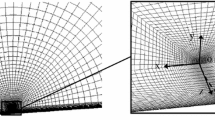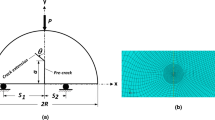Abstract
Whatever the external loading, a crack front in a solid tries to reach mode I loading conditions after propagation. In mode I + II, the crack kinks to annihilate mode II, kinking angle being well predicted by the principle of local symmetry (PLS) or by the maximum tangential stress criterion (MTS). In presence of mode III, the problem becomes three-dimensional and the proposed propagation criterion are not yet well proved and established. In particular in three point bending experiments (3PB) with an initially inclined crack, the crack twists around the direction of propagation to finally reach a situation of pure mode I. The aim of the paper is to compare the propagation paths predicted by two different criteria for 3PB fatigue experiments performed on PMMA. The first criterion developed by Schollmann et al. (Int J Fract 117(2):129–141, 2002), is a three-dimensional extension of the MTS criterion and predicts the local angles that annihilates mode II and III at each point of the front. The second one developed by Lazarus et al. (J Mech Phys Solids 49(7):1421–1443, 2001b), predicts an abrupt and then progressive twisting of the front to annihilate mode III. Due to presence of sign changing mode II and almost uniform mode III in the experiments, both criteria give good results. However, since mode III is predominant over mode II in the case under consideration, the global criterion gives better results. Nevertheless, the local type criterion seems to be of greater universality for practical engineering applications.
Similar content being viewed by others
References
Amestoy M, Leblond JB (1992) Crack paths in plane situations—II. Detailed form of the expansion of the stress intensity factors. Int J Solids Struct 29: 465–501
Aydin A, Pollard DD (1988) Progress in understanding jointing over the past century. Geol Soc Am Bull 100: 1181–1204
Bazant Z, Estenssoro L (1979) Surface singularity and crack propagation. Int J Solids Struct 15(5): 405–426
Buchholz FG (1984) Improved formulae for the finite element calculation of the strain energy release rate by the modified crack closure integral method. In: Robinson J(eds) Accuracy, reliability and training in FEM technology. Robinson and Associates, Dorset, pp 650–659
Buchholz FG, Wang H, Lin J, Richard HA (1998) 3d fracture analyses and experimental results on three-point bend specimens with slant cracks. In: Atluri SN, O’Donoghue PE (eds) Modeling and simulation based engineering. Proceedings of the international conference of engineering science (ICES 98), vol II, Tech Science Press: Palmdale, Atlanta, Georgia, USA, pp 1238–1243
Buchholz FG, Chergui A, Richard HA (2004) Fracture analyses and experimental results of crack growth under general mixed mode loading conditions. Eng Fract Mech 71(4–6): 455–468
Buchholz FG, Wiebesiek J, Fulland M, Richard H (2005) Comparison of computational 3d crack path simulations with experimental findings for 3pb-specimens with inclined crack planes. In: Aliabadi MH, Buchholz FG, Alfaite J (eds) Advances in fracture and damage mechanics IV. Proceedings of the 4th international conference on fracture and damage mechanics (FDM05), EC Ltd: UK, Mallorca, Spain, pp 143–148
Cooke ML, Pollard DD (1996) Fracture propagation paths under mixed mode loading within rectangular blocks of polymethyl methacrylate. J Geophys Res 101(B2): 3387–3400
Erdogan G, Sih GC (1963) On the crack extension in plates under plane loading and transverse shear. ASME J Basic Eng 85: 519–527
Fulland M, Schöllmann M, Richard HA (2000) Adapcrack3d-development of the program for the simulation of three-dimensional crack propagation processes. In: Atluri SN, Brust FW(eds) Advances in computational engineering & sciences. Tech Science Press, Palmdale, USA, pp 948–953
Goldstein RV, Salganik RL (1974) Brittle fracture of solids with arbitrary cracks. Int J Fract 10: 507–523
Gravouil A, Moes N, Belytschko T (2002) Non-planar 3d crack growth by the extended finite element and level sets. II. Level set update. Int J Numer Methods Eng 53(11): 2569–2586
Hourlier F, Pineau A (1979) Fissuration par fatigue sous sollicitations polymodales (mode I ondulé + mode III permanent) d’un acier pour rotors 26 NCDV 14. Mémoires Scientifiques de la Revue de Métallurgie pp 175–185
Hull D (1993) Tilting cracks: the evolution of fracture surface topology in brittle solids. Int J Fract 62(2): 119–138
Lazarus V, Leblond JB (1998) Crack paths under mixed mode (I + III) or (I + II + III) loadings. Comptes Rendus de l’Académie des Sciences, Série II (Mécanique, Physique, Astronomie) 326(3): 171–177
Lazarus V, Leblond JB, Mouchrif SE (2001a) Crack front rotation and segmentation in mixed mode I + III or I + II + III—part I: calculation of stress intensity factor. J Mech Phys Solids 49(7): 1399–1420
Lazarus V, Leblond JB, Mouchrif SE (2001b) Crack front rotation and segmentation in mixed mode I + III or I + II + III—part II: comparison with experiments. J Mech Phys Solids 49(7): 1421–1443
Leblond JB (1989) Crack paths in plane situations—I. General form of the expansion of the stress intensity factors. Int J Solids Struct 25: 1311–1325
Makabe C, Anggit M, Sueyoshi T, Yafuso T (2006) The formation mechanism of the factory-roof pattern in a torsional fatigue specimen with circumferential notch. J Test Eval 34(5): 423–429
Palaniswamy K, Knauss WG (1975) Crack extension in brittle solids. Mechanics Today, Pergamon Press 4:87
Pollard DD, Segall P, Delaney PT (1982) Formation and interpretation of dilatant echelon cracks. Geol Soc Am Bull 93: 1291–1303
Pook L (1995) On fatigue crack paths. Int J Fatigue 17(1): 5–13
Qian J, Fatemi A (1996) Mixed mode fatigue crack growth: a literature survey. Eng Fract Mech 55(6): 969
Rybicki EF, Kanninen MF (1977) A finite element calculation of stress intensity factors by a modified crack closure integral. Eng Fract Mech 9: 931–938
Schollmann M, Richard H, Kullmer G, Fulland M (2002) A new criterion for the prediction of crack development in multiaxially loaded structures. Int J Fract 117(2): 129–141
Schollmann M, Fulland M, Richard HA (2003) Development of a new software for adaptive crack growth simulations in 3d structures. Eng Fract Mech 70(2): 249–268
Sommer E (1969) Formation of fracture ‘lances’ in glass. Eng Fract Mech 1: 539–546
Yates JR, Mohammed RA (1996) Crack propagation under mixed mode (I + III) loading. Fatigue Fract Eng Mater Struct 19(10): 1285–1290
Author information
Authors and Affiliations
Corresponding author
Rights and permissions
About this article
Cite this article
Lazarus, V., Buchholz, FG., Fulland, M. et al. Comparison of predictions by mode II or mode III criteria on crack front twisting in three or four point bending experiments. Int J Fract 153, 141–151 (2008). https://doi.org/10.1007/s10704-008-9307-2
Received:
Accepted:
Published:
Issue Date:
DOI: https://doi.org/10.1007/s10704-008-9307-2




